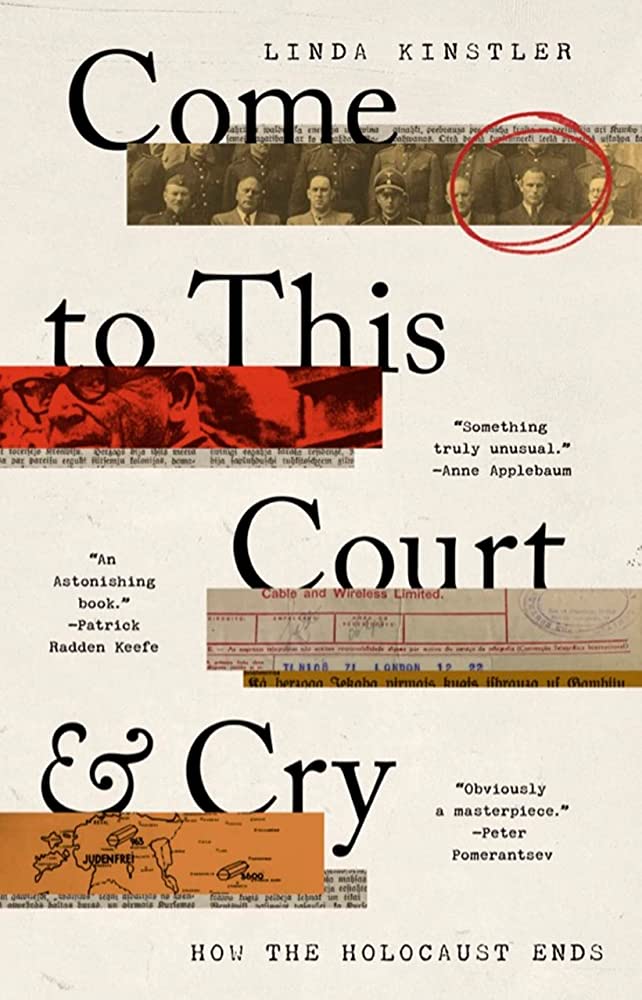Linda Kinstler is a contributing writer for Jewish Currents and The Economist’s 1843 Magazine, and the deputy editor of The Dial. Her writing has been cited by the International Court of Justice and has inspired documentaries. Kinstler’s work appears in The New York Times, Washington Post, The Atlantic, Wired, and more. Come to This Court and Cry: How the Holocaust Ends is her first nonfiction book. She is currently completing a Ph.D in the Rhetoric Department at U.C. Berkeley, where her dissertation is a legal genealogy of oblivion.

-
Come to This Court and CryHow The Holocaust Ends
She went to school with other Russian-speaking children, some of whom were Latvian Jews, sons and daughters of the lucky few who had been hidden away by righteous gentiles, or who had fought with the famous 43rd Latvian Rifle Guards Battalion of the Soviet army. The others, like her own family, had moved to Riga after the war, their families mostly intact, having spent the war in the eastern evacuation zones.
Some of her schoolteachers were survivors themselves, but no one knew for sure. The survivors, they were silent. They had not yet been glorified, honoured, beatified. They simply went about their lives as best they could. Only decades later did my mother find out that the school principal, Nina Dmitrievna Alieva, was an inmate in Salaspils concentration camp. Only later did she learn of rumours that their strict chorus teacher had climbed out of a ditch in Rumbula. Come to This Court and Cry:How The Holocaust Ends
Come to This Court and Cry:How The Holocaust Ends- Print Books
- Find your local bookstore (via IndieBound)
- Bookshop
-
Come to This Court and CryHow The Holocaust Ends
I hurried through the gate and found myself standing alone on a wide, open walkway lined with linden trees. This was the Road of Contemplation, the long path separating the world of the living from that of the dead, a symbolic River Styx. ‘The living on one side, and the dead on the other,’ a guide to the cemetery explains. Every year, Latvians walk the five kilometres separating the Freedom Monument in the city centre to the cemetery. They carry candles, flowers and flags as they proceed, each step reminding them of their own inexorable march towards death, each step bringing them closer to the fallen. The university fraternities march in groups, the Lettonia men wearing their green and yellow caps. The Road of Contemplation is only 200 metres long, but in some sense it spans the entire nation.
 Come to This Court and Cry:How The Holocaust Ends
Come to This Court and Cry:How The Holocaust Ends- Print Books
- Find your local bookstore (via IndieBound)
- Bookshop
-
Come to This Court and CryHow The Holocaust Ends
The trial was a spectacle in every sense of the word, a striking public display of grief, mourning, terror and mystification. The judges in their billowing black robes, their judicial dress ‘infused with a primitive kind of alchemical power,’ Rogat writes. The defendant seated in his bullet-proof glass box, flanked by his guards. The theater was packed; on some days, spectators lined up around the block for a chance to partake in the proceedings. A special police unit, ‘Bureau 06’, had prepared the evidence: 1,600 documents on the Nazi programme to annihilate the Jewish people, many of them bearing Eichmann’s signature. One hundred and eight survivors took the stand. They swore on the Hebrew Bible, they listed the names of the dead.
 Come to This Court and Cry:How The Holocaust Ends
Come to This Court and Cry:How The Holocaust Ends- Print Books
- Find your local bookstore (via IndieBound)
- Bookshop
“Avoiding any simplistic or definitive conclusions, Kinstler provides a model of deep historical research and fluid, engaging narrative.” —New York Journal of Books [on Come to This Court and Cry]
“Victims and perpetrators meet in Kinstler’s bloodline . . . . This is a tremendous feat of storytelling, propelled by numerous twists and revelations, yet anchored by a deep moral seriousness . . . . Enthralling, sobering." —The Guardian [on Come to This Court and Cry]
“A masterful synthesis of family history and Holocaust investigation that blurs lines among perpetrators, justice, and national identity . . . . A vital addition to the finite canon of Holocaust studies rooted in personal connection.” —Kirkus (starred review) [on Come to This Court and Cry]
“Kinstler sets out to solve a mystery—journeying from a murder scene in Uruguay to the former killing fields of Europe to unravel a family secret about her late grandfather—and in the process unearths vexing questions about the past and how we understand it. Part detective story, part family history, part probing inquiry into how best to reckon with the horrors of a previous century, Come to This Court and Cry is bracingly original, beautifully written, and haunting.” —Patrick Radden Keefe
Selected Works

- Print Books
- Find your local bookstore (via IndieBound)
- Bookshop
Nimbly reanimating the forgotten or concealed past, Linda Kinstler’s reportage bristles with eagerness, moving like the spy thrillers she tips her hat to. She vividly renders the tense maneuvering of agents and assassins and the chilling crimes of the Nazis, but also the quiet heroics of bureaucrats who gumshoe toward justice. Kinstler is crafting a fresh and tautly controlled genre in which familial accountability meets historical reckoning.